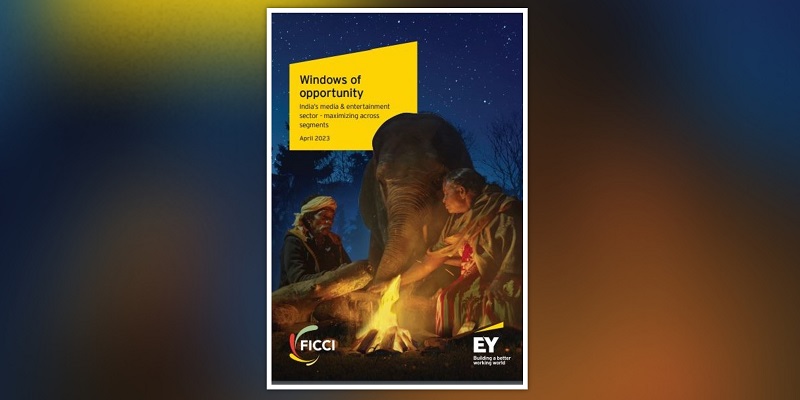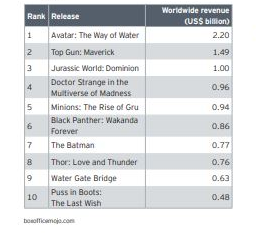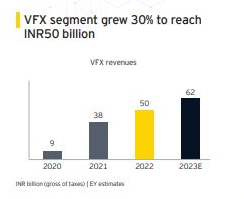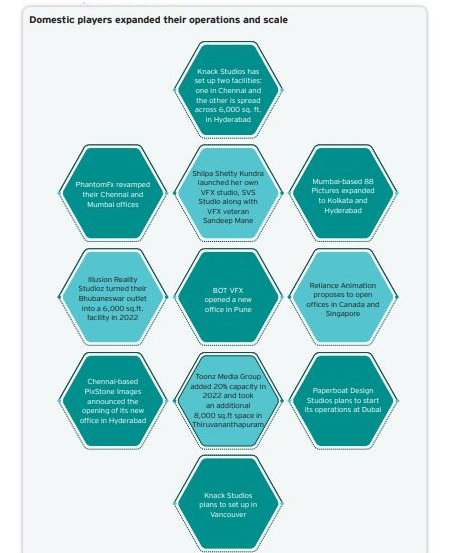
The content creators are upping their storytelling with marvellous VFX advancements. The recent FICCI EY report confirms the exponential growth of India’s M&E space with VFX and post production facilities moving up the value chain. The report states that the VFX segment grew 30 per cent to reach INR 50 billion.
The key factors that contributed to the growth are:
A) VFX-heavy content witnessed high demand globally:
- Tentpole movies, which were VFX-heavy, continued to draw audiences across theatres as well as OTT platforms. As per the report, the top 10 grossing films of 2022 were all VFX-heavy films:
- The share of VFX in a Hollywood big-budget movie continued to increase:
- VFX budget for a film with a US $100 million production budget or more rose to 30 to 35 per cent from 25 to 30 per cent previously
- VFX share of mid to low-budget films has also increased by 5 to 10 per cent
- OTT platforms continued to invest heavily in original content production globally, amounting to US$60 billion in 2022
- Approximately 70 to 75 per cent of the Indian VFX segment revenue came from service exports in 2022
B) Domestic film market also increased VFX spends:
- 2022 recorded a two times increase in the number of big budget movies (greater than or equal to INR1 billion) compared to 2021
- The share of VFX for a low to mid-size film was in the range of 10 to 15 per cent of the budget, wherein for a big budget movie the share of VFX was 25 to 30 per cent; 25 to 30 per cent of the total production budget was allotted to VFX works for movies like Brahmastra, RRR and Adi Purush.
- Indian film makers have increased the number of shots in their high-budget films from a few hundred to 1,500- 2,000
- Brahmastra Part One: Shiva had over 4,500 VFX shots, potentially making it the Indian film with the most VFX shots till date
- SS Raja Mouli’s RRR had a total of 2,800 VFX shots. 70 to 80 per cent of the shots were done using CGI
C) Top global VFX players expanded into India to leverage the cost arbitrage that India continues to offer:
- For a global VFX player having operations in India, Indian VFX artists cost only one-eighth of the cost incurred on hiring artists in the UK or North America
- In the last two years alone, the Indian visual effects industry has created 60,000 jobs, with studios like MPC in Bengaluru going for an extensive hiring spree
- In 2022, five global VFX players, including ILM, have either started operations or announced their entry into the Indian market:
- Industrial Light & Magic (ILM) opened its new office in Mumbai. ILM plans to acquire and retain over 500 skilled talents in India over the next three years
- UK-based Cinesite group acquired a majority stake in Assemblage Entertainment, headquartered in Mumbai
- Detroit-headquartered US tech firm, Pi Square Technologies, opened its global animation and VFX studio in Hyderabad
- Ghost VFX, Streamland media’s visual effects division, has announced it will open a new 32,000-square-foot studio in Pune, Maharashtra, India, in early 2023 to meet the growing needs of filmmakers worldwide
- FOLKS, a Fuse Group visual effects company, has launched its 35000+ square foot facility in Mumbai, India. The facility will staff more than 250 employees
D) Studios embraced technologies like virtual production, AI and ML to streamline workflows and allow quicker iterations:
- Volume of outsourced work and the complexity levels of the sequences delivered in India have increased considerably compared to what it was a decade ago
- To streamline the creative and technical process and allow quicker iterations for a client, VFX players are embracing artificial intelligence, Machine learning and deep learning
- With the rise of the hybrid working model, improvement in cloud computing, which enables remote work, made it even more possible for people across geographies to work in the same pipeline
- More virtual production studios were set up in 2022:
- K. Sera Sera and Vikram Bhatt have opened India’s first virtual production studio on the Dahisar Highway, Mumbai, spread over 50,000 sq. ft.
- The Chennai-based film technology company Qube Cinema has teamed up with actor Akkineni Nagarjuna’s Annapurna Studios and launched a full service virtual production stage in Hyderabad
The Report also highlights availability of skilled talent as the key challenge for VFX industry:
Most of the industry leaders raised concerned about the inability to find technically skilled employees to meet the opportunities provided by the high global and domestic demand for content.
- The median age of artists in the Indian VFX and animation segment is 23 to 25 years with 85 to 90 per cent of these artists conditioned on the job
- The attrition rate in the VFX segment in 2022 was 25 to 30 per cent. High poaching of mid-level talent was also observed in the segment
The industry leaders focused on finding skilled employees to meet the opportunities provided by the high global and domestic demand for content. Some of them implemented training programs to acquire, retain and up-skill talent:
- Phantom VFX took several initiatives like visiting university campuses and grooming talent by taking on board people with good skills in art or technology for three-month-long paid training programs
- With a team of 75 people, the studio Hoop VFX started a training program which gave on-the-job training to college graduates and provided them with an opportunity to build a career in the VFX segment
- In 2022, Framestore’s renowned global accelerator program, Launchpad Pro, was launched. This platform is aimed at bringing in more VFX aspirants into the industry
Also, the post-production grew 35 per cent in 2022 to reach INR 19 billion. The major highlights are:
- There is a surge in dubbed and sub-titled theatrical releases as India becomes one market, with content appealing to audiences across state and language boundaries
- Dubbed films increased from 15 per cent of all releases pre-pandemic, to 30 per cent in 2022
- Over the last decade, the cost of dubbing for an average film has gone up from INR 0.5 million to INR 2 million to INR 3 million
- As content is monetised across more windows (SVOD, AVOD, theatrical, television, FTA, international, short video etc.) the demand for post-production services will continue to grow
Future Trends:
1) Demand for tentpole movies and VFX-heavy episodic content will continue to drive growth
- More than 50+ upcoming VFX-heavy movies are expected to be released in 2023 and early 2024
- 1,000+ original titles are expected to be commissioned across the top 10 OTT platforms over the next few years
- Marvel is introducing 10 new characters in phase four of its MCU, which creates the possibility spin-off TV shows and web series
- Tier one players like ILM, DNEG, Framestore and Technicolor have marked their entry into the Indian market to take advantage of our talent pool and technological capabilities, and are looking to at the very least double their headcount in India ensure better margins as their clients, the global studios and streaming platforms, aim for better profitability/ breakeven
2) There is a need to build the talent pool, urgently, as recommended by the AVGC taskforce- The AVGC task force emphasises developing the three Ts (Talent, Technology and Tools) to achieve India’s vision of achieving 5 per cent of the global market by 2025.




